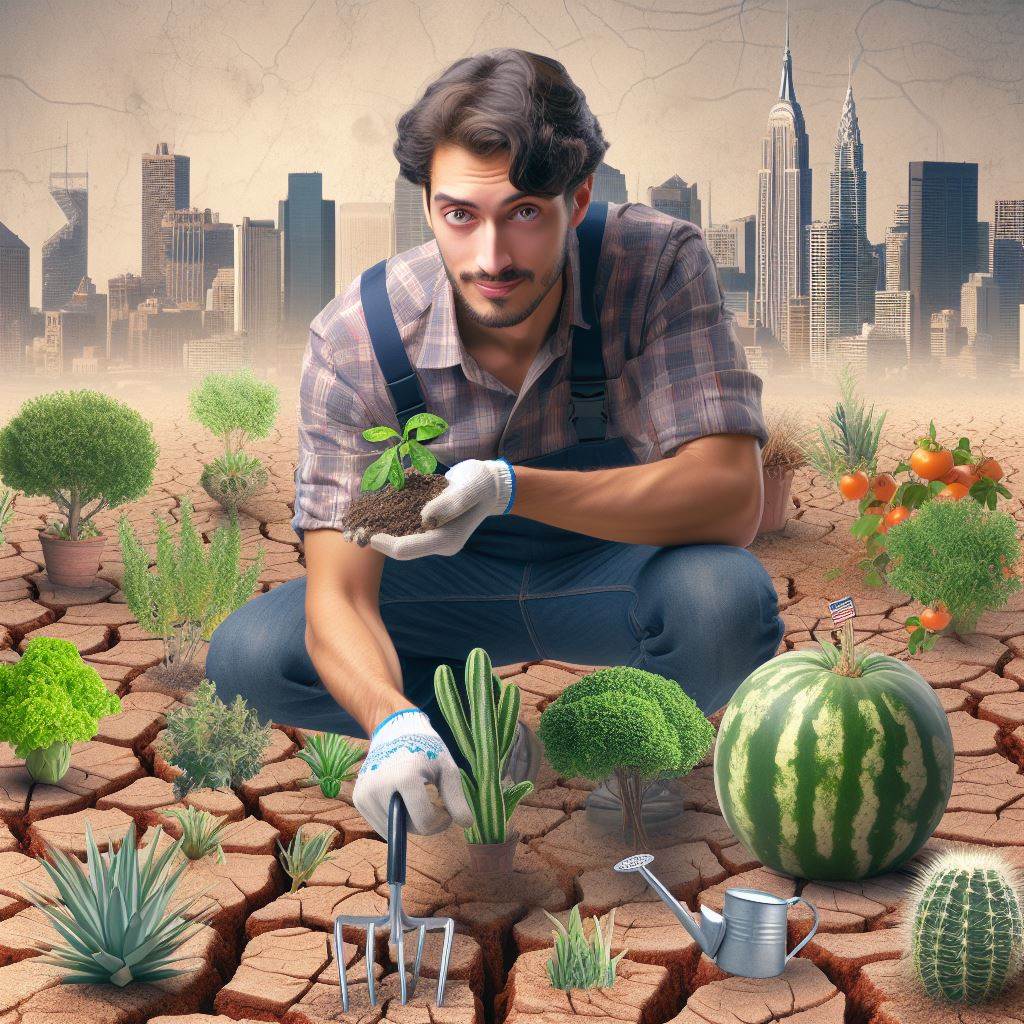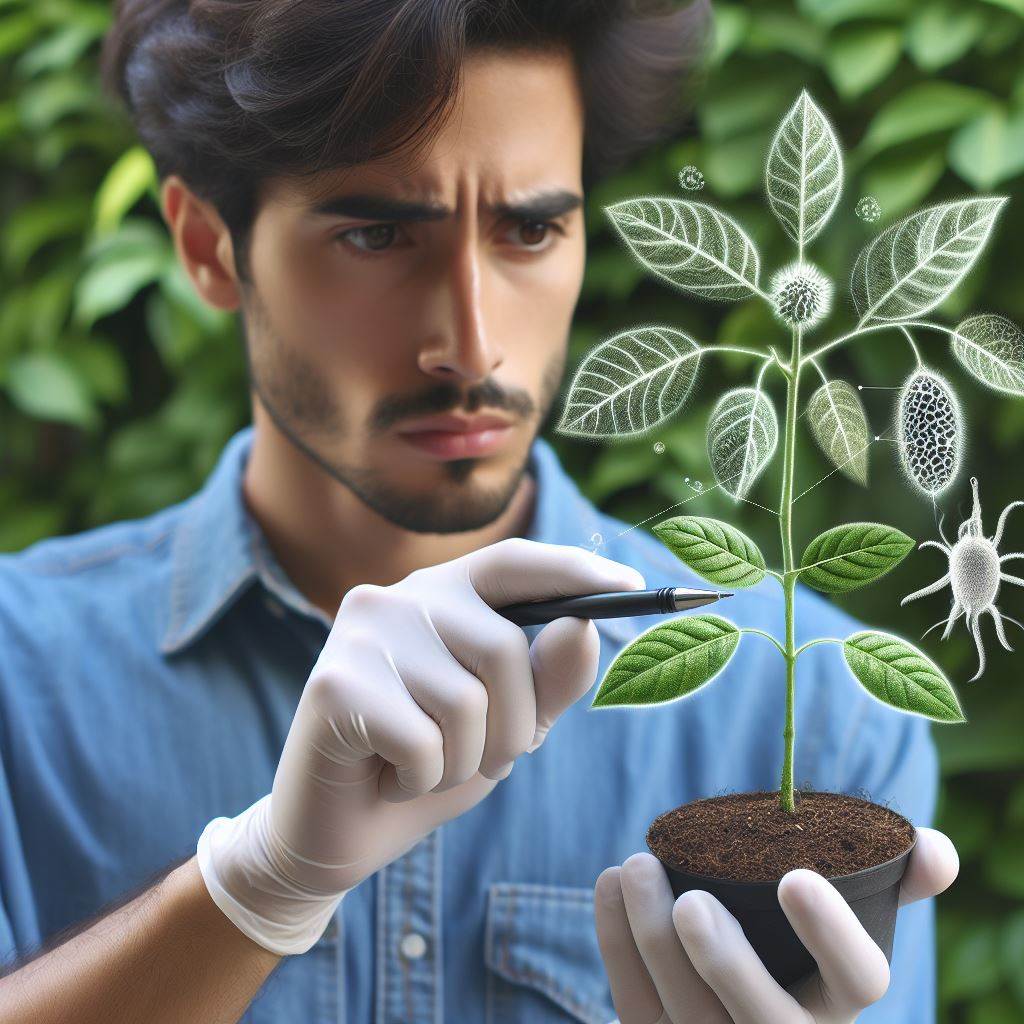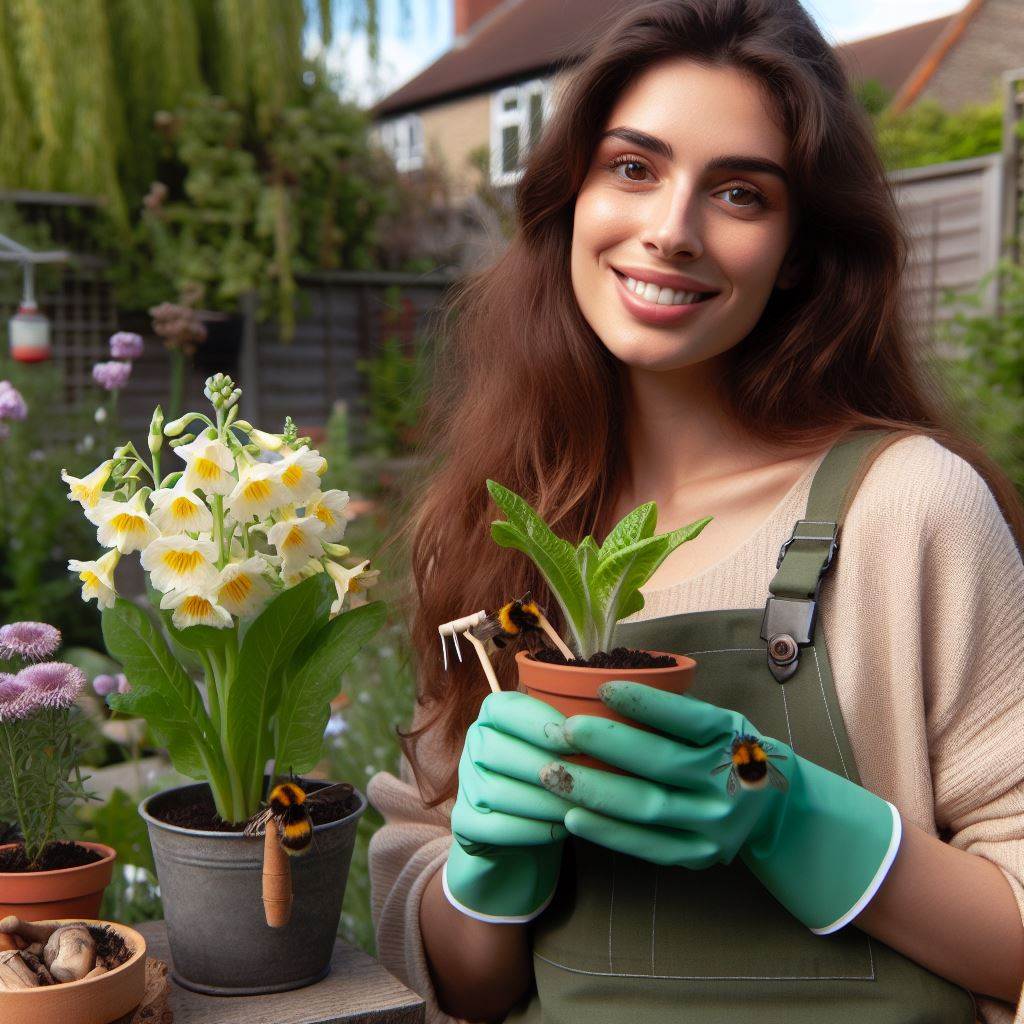Introduction
Drought conditions in gardening
Gardening in drought conditions can be challenging due to limited water availability and unfavorable growing conditions.
As water becomes scarce, it is necessary to adapt gardening techniques to ensure the survival and productivity of your plants.
In this post, we will explore various tips and strategies that can help you achieve successful gardening despite the drought.
Importance of adapting gardening techniques in drought conditions
One of the key aspects of gardening in drought conditions is efficient water usage.
By implementing water-saving techniques such as drip irrigation and mulching, you can minimize water wastage and ensure that your plants receive the necessary moisture.
Additionally, selecting drought-tolerant plant varieties and incorporating native plants into your garden can help reduce water requirements.
Another important aspect to consider is soil management.
Improving soil structure and fertility through the addition of organic matter and compost can enhance water retention and reduce the need for frequent irrigation.
Furthermore, proper weed control and regular monitoring of your garden can help detect early signs of drought stress, allowing you to take timely action.
Tips and strategies for successful gardening in drought conditions
Furthermore, it is crucial to adjust your gardening practices to match the unique demands of drought conditions.
This may include altering planting schedules, practicing proper pruning techniques, and providing shade or windbreaks to protect your plants from excessive heat and evaporation.
Therefore, gardening in drought conditions requires careful planning and implementation of specific strategies.
By adopting water-saving techniques, enhancing soil health, and adjusting gardening practices, you can overcome the challenges presented by drought and maintain a thriving garden.
In the following sections, we will delve deeper into each of these strategies and provide practical tips for successful gardening in drought conditions.
Understanding Drought Conditions
Definition of drought
Drought refers to a prolonged period of little or no rainfall, resulting in water scarcity.
Transform Your Agribusiness
Unlock your farm's potential with expert advice tailored to your needs. Get actionable steps that drive real results.
Get StartedIt is characterized by dry weather conditions that exceed the norm, leading to moisture deficiency.
Effects of drought on gardening
- Stunted plant growth: Lack of water can hinder photosynthesis and nutrient absorption, limiting plant growth.
- Reduced crop yield: Insufficient water supply leads to smaller, underdeveloped fruits and vegetables.
- Increased pest invasion: Drought weakens plants, making them more susceptible to pests and diseases.
- Soil degradation: Without proper hydration, soil quality deteriorates, causing decreased fertility and increased erosion.
- Limited plant diversity: Drought conditions restrict the ability to grow a wide variety of plants.
Factors contributing to drought conditions in different regions
- Climate change: Rising global temperatures disrupt weather patterns, leading to more frequent and severe droughts.
- El Niño and La Niña: These climate phenomena can impact rainfall patterns, resulting in prolonged dry spells.
- Geographic location: Areas near deserts or mountain ranges may naturally experience less rainfall, increasing the risk of drought.
- Deforestation: Clearing forests reduces evapotranspiration, leading to decreased rainfall and drought conditions.
- Overpopulation and water demand: High population densities strain water resources, exacerbating drought conditions.
In regions facing drought conditions, understanding the impacts and causes is essential for effective gardening practices.
By recognizing drought as a prolonged period of water scarcity, gardeners can take proactive measures to adapt and mitigate its effects.
Drought significantly affects gardening, leading to stunted plant growth, reduced crop yield, pest invasion, soil degradation, and limited plant diversity
To combat these challenges, gardeners can implement various techniques and strategies.
Water conservation
- Collect and store rainwater using barrels or cisterns for later use in the garden.
- Use drip irrigation systems or soaker hoses to deliver water directly to plant roots, minimizing evaporation.
- Mulch garden beds to retain soil moisture, reduce weed growth, and regulate soil temperature.
Selecting drought-tolerant plants
- Choose plant varieties that are naturally adapted to arid conditions, such as succulents and native species.
- Opt for plants with deep root systems, enabling them to access water deeper in the soil.
Improving soil quality
- Add organic matter like compost or aged manure to enhance soil structure and water-holding capacity.
- Use cover crops or green manure to prevent soil erosion and improve moisture retention.
Implementing efficient garden management
- Schedule watering in the early morning or late evening to minimize water loss through evaporation.
- Group plants with similar water requirements together, allowing for targeted watering.
Most importantly, comprehending the definition and effects of drought on gardening is crucial for successful plant cultivation.
Recognizing the contributing factors to drought conditions in different regions helps gardeners better adapt to challenging circumstances.
By implementing water conservation methods, selecting drought-tolerant plants, improving soil quality, and practicing efficient garden management, gardeners can minimize the negative impacts of drought and achieve successful gardening even in arid conditions.
Read: Balcony Farming: Urban Agriculture Tips
Planning for Water Conservation
Assessing available water resources
- Determine the amount of water you have access to for gardening.
- Consider any restrictions or regulations on water usage in your area.
- Check if there are any water-saving incentives or programs offered by your local government.
Calculating water requirements for different plants
- Understand the specific water needs of the plants you want to grow.
- Take into account factors such as the plant’s size, growth stage, and sunlight exposure.
- Consult gardening resources or experts to determine the optimal watering schedule for each plant.
Creating a water conservation plan
Collecting rainwater
- Install rain barrels or cisterns to capture rainwater from roofs.
- Use collected rainwater for watering plants during dry periods.
Using graywater for irrigation
- Consider reusing water from activities like dishwashing, laundry, or bathing.
- Ensure that the graywater does not contain harsh chemicals or pollutants harmful to plants.
Implementing drip irrigation systems
- Use drip irrigation instead of traditional sprinklers to minimize water usage.
- Place the emitters directly at the plant’s root zone for efficient water delivery.
Mulching
- Apply a layer of organic mulch around plants to retain moisture in the soil.
- Mulch helps prevent evaporation and keeps the soil cooler during hot weather.
Grouping plants according to water needs
- Cluster plants with similar water requirements together in your garden.
- This allows for targeted watering and prevents wastage on plants that don’t need as much water.
Regular maintenance and monitoring
- Check for leaks or inefficient watering systems regularly.
- Adjust watering schedules based on weather conditions and plant needs.
Proper soil preparation
- Improve soil quality by adding organic matter, which enhances water retention.
- Well-draining soil helps prevent waterlogged conditions that can harm plants.
Selecting drought-tolerant plants
- Choose plants that are naturally adapted to arid conditions.
- These plants require less water and are more likely to thrive in drought conditions.
By following these water conservation strategies, you can maintain a thriving garden even during drought conditions.
Read: Soil Health: Key to Thriving Gardens
Choosing the Right Plants
Selecting Drought-Resistant Plant Varieties
- Look for plants that have been specifically bred or selected for their ability to thrive in drought conditions.
- Choose plants that have adaptations such as deep root systems or waxy leaves to reduce water loss.
- Research and ask local nurseries for recommendations on drought-resistant plant varieties that are suitable for your region.
Native and Adaptive Plant Species for Drought Conditions
- Consider using native plants that are naturally adapted to your local climate and soil conditions.
- These native species have evolved over time to survive and thrive in your specific region’s drought conditions.
- By using native plants, you can reduce the need for excessive watering and maintenance.
Grouping Plants Based on Water Requirements
- Organize your garden by grouping plants with similar water needs together.
- This practice allows for more efficient watering, as you can avoid overwatering drought-resistant plants.
- By segregating plants based on water requirements, you can create microclimates within your garden and conserve water.
Maximizing Use of Succulents and Xeriscaping Techniques
- Succulents, such as cacti and agave, are excellent choices for drought-prone areas due to their ability to store water.
- Incorporate xeriscaping techniques, which involve using drought-tolerant plants and landscaping practices to conserve water.
- Xeriscaping can include using mulch, minimizing turf areas, and implementing efficient irrigation systems.
By selecting drought-resistant plant varieties, native species, and grouping plants based on water requirements, you can create a beautiful garden that thrives even in drought conditions.
Additionally, incorporating succulents and xeriscaping techniques maximizes water conservation, reducing the need for excessive watering.
Remember, a little research and planning can go a long way in achieving a vibrant and sustainable garden while dealing with water scarcity.
Read: Backyard Permaculture: Sustainable Techniques

Soil Management
Improving soil quality and structure
One of the key aspects of gardening in drought conditions is to improve soil quality and structure.
By doing so, the soil becomes more conducive to retaining and utilizing water efficiently.
- Adding organic matter: Incorporating organic matter such as compost, manure, or leaf litter into the soil helps improve its structure. This allows for better water infiltration and root penetration.
- Breaking up compacted soil: Compacted soil prevents water from penetrating, resulting in runoff and wastage. Aerating the soil or using a garden fork to loosen it promotes better water absorption.
- Avoiding over-tilling: Excessive tilling disrupts the soil structure and can lead to increased evaporation. Minimize tilling to preserve the soil’s natural moisture-holding capacity.
Enhancing soil water retention capacity
To combat dry conditions, it is essential to enhance the soil’s ability to retain water.
This ensures that plants have access to sufficient moisture, even during drought periods.
- Using organic polymers: Bio-based polymers such as hydrogels or superabsorbent polymers can be mixed into the soil. These materials absorb and retain water, slowly releasing it to plant roots.
- Incorporating clay minerals: Clay minerals, such as bentonite or montmorillonite, can be added to the soil. They have high water-holding capacities, increasing the overall moisture availability.
- Implementing drip irrigation: Drip irrigation delivers water directly to plant roots, minimizing evaporation and reducing water waste. This technique maximizes the efficiency of water usage.
Mulching as a water-saving technique
Mulching plays a crucial role in conserving soil moisture and regulating the soil temperature.
It acts as a protective barrier against evaporation and weed growth.
- Organic mulch options: Using organic materials like wood chips, straw, or compost as mulch helps retain soil moisture. These materials break down over time, enriching the soil.
- Applying a layer of mulch: Spread a layer of mulch around plants, leaving a small gap around the stem to prevent rot. This covering helps retain soil moisture and reduce water loss.
- Mulching thickness: Ensure the mulch layer is around 2-4 inches thick to provide adequate coverage. Thicker layers can obstruct water absorption, and thinner layers may not be effective.
Composting for soil fertility and moisture retention
Composting is a sustainable way to improve soil fertility and moisture retention.
It enriches the soil with nutrients, enhances its water-holding capacity, and promotes overall plant health.
Showcase Your Farming Business
Publish your professional farming services profile on our blog for a one-time fee of $200 and reach a dedicated audience of farmers and agribusiness owners.
Publish Your Profile- Composting techniques: Set up a compost bin or pile using a mix of green and brown materials, including kitchen scraps, yard waste, and leaves. Moisture control is essential for effective decomposition.
- Adding compost to soil: Incorporate mature compost into the soil before planting or top-dress existing plants with a thin layer. This enriches the soil and increases its ability to retain moisture.
- Compost tea: Utilize compost tea, a liquid fertilizer made from steeping compost in water. Apply it to the soil or as a foliar spray to provide nutrients and improve water retention.
In essence, effective soil management is vital for successful gardening in drought conditions.
By improving soil quality, enhancing water retention, utilizing mulching, and implementing composting techniques, gardeners can optimize water usage and nurture resilient plants.
Read: Edible Landscaping: Beauty and Bounty
Efficient Irrigation Practices
In gardening, water is a precious resource, especially in drought conditions.
To conserve water while still maintaining a healthy garden, it is crucial to implement efficient irrigation practices.
This section focuses on various techniques and considerations for watering plants during periods of water scarcity.
Watering techniques for drought conditions
- Timing of watering: The timing of watering plays a significant role in water conservation. Watering early in the morning or late in the evening reduces evaporation rates and ensures maximum water absorption by plants.
- Watering deeply but infrequently: Instead of frequent shallow watering, it is advisable to water deeply but less often. This promotes deep root growth and helps plants withstand drought by accessing water stored deeper in the soil.
- Avoiding overhead watering: Overhead watering, such as using sprinklers, often leads to water wastage due to evaporation and wind drift. Drip irrigation or soaker hoses are more water-efficient options as they directly target the plant roots, minimizing water loss and reducing the risk of fungal diseases caused by leaf wetting.
Proper irrigation equipment selection
Choosing appropriate irrigation equipment is key to reducing water waste and ensuring effective water distribution.
Consider the following factors when selecting irrigation tools:
- Type of plants: Different plants have varying water requirements. Select equipment that can tailor the water delivery based on specific plant needs.
- Soil type: Soil composition affects water absorption and drainage. Equipment that accounts for soil type can prevent overwatering or water runoff.
- Efficiency: Look for irrigation systems with high water-use efficiency, such as drip irrigation or micro-sprinklers, which minimize water loss through evaporation or runoff.
Monitoring soil moisture levels
Regularly monitoring the moisture content in the soil is vital to prevent both under and overwatering.
Here are some methods to assess soil moisture levels:
- Visual inspection: Check the soil’s appearance and texture. Dry soil often appears light in color, clumpy, and powdery, while moist soil appears darker and crumbly.
- Finger test: Insert your finger into the soil up to the second knuckle. If it feels dry at that depth, it’s time to water. If it feels moist, hold off on watering.
- Moisture meters: Use a moisture meter to measure the soil’s moisture content accurately. These tools provide precise readings and help determine when watering is necessary.
Efficient irrigation practices are essential for successful gardening during drought conditions.
By adopting appropriate watering techniques, selecting the right irrigation equipment, and monitoring soil moisture levels, gardeners can minimize water usage while still cultivating healthy and thriving plants.
Weed and Pest Management
Preventing weed growth and competition for water
- Use mulch to suppress weed growth by blocking sunlight and conserving soil moisture.
- Pull weeds regularly to prevent them from establishing deep roots and stealing water from your plants.
- Plant ground covers or dense crops to shade out weeds and minimize water competition.
- Avoid overwatering, as this can encourage weed growth and waste valuable water resources.
- Use weed barriers or landscape fabric to prevent weed seeds from germinating and taking root.
Implementing natural pest control methods
- Encourage beneficial insects, such as ladybugs and lacewings, to control pests naturally.
- Install bird feeders or birdhouses to attract birds that eat insects harmful to your garden.
- Use companion planting to repel pests or attract beneficial insects, like planting marigolds to deter aphids.
- Create a diversity of plants to attract a variety of insects, which can help control pest populations.
- Apply organic pest control solutions, like neem oil or insecticidal soaps, sparingly and only as needed.
Reducing plant stress and vulnerability to pests
- Provide adequate water to your plants, focusing on deep, infrequent watering to encourage deep root growth.
- Apply a layer of organic compost or mulch around the base of plants to conserve moisture and protect roots.
- Avoid planting susceptible plants in areas prone to pest infestations or known disease outbreaks.
- Monitor plants regularly for signs of stress or pest damage, and take immediate action if necessary.
- Prune plants to improve air circulation, reduce overcrowding, and prevent pest infestations.
By following these weed and pest management strategies, you can maintain a healthy and thriving garden even in drought conditions.
Remember to act promptly at the first signs of weed growth or pest infestation to prevent them from spreading and causing further damage.
Adopting Sustainable Gardening Practices
Sustainable gardening principles
- Use native plants that are adapted to drought conditions.
- Practice proper irrigation techniques to minimize water waste.
- Implement efficient mulching to reduce evaporation and conserve soil moisture.
- Promote biodiversity by creating habitats for beneficial insects and wildlife.
- Minimize chemical pesticide and herbicide use to protect the environment.
Organic fertilizers and amendments for water conservation
- Use compost, a rich source of organic matter, to improve soil structure and water-holding capacity.
- Add organic fertilizers, such as fish emulsion or seaweed extract, to provide essential nutrients to plants.
- Utilize natural amendments like perlite or vermiculite to enhance water drainage in heavy clay soils.
- Apply mulch made from organic materials, like wood chips or straw, to retain soil moisture.
- Employ rainwater harvesting systems to collect and reuse natural water resources.
Companion planting for pest management and water efficiency
- Pair compatible plants that work together to repel pests and attract beneficial insects.
- Grow marigolds, a natural pest deterrent, around vegetables to protect them from aphids or nematodes.
- Plant aromatic herbs, like basil or rosemary, to repel mosquitoes and other unwanted insects.
- Interplant larger plants to provide shade and reduce moisture evaporation from the soil surface.
- Use trellises or vertical gardening techniques for efficient space utilization and improved air circulation.
By adopting sustainable gardening practices, you can not only create a beautiful and productive garden but also minimize the impact on natural resources and the environment.
Conclusion
Gardening in drought conditions can be challenging, but with the right strategies, it is still possible to cultivate a thriving garden.
Here is a recap of the key tips that can help you succeed:
- Choose drought-tolerant plants that can survive with minimal water.
- Use mulch to conserve moisture, suppress weeds, and regulate soil temperature.
- Implement efficient watering techniques like drip irrigation or using a soaker hose.
- Collect and utilize rainwater or graywater for watering your plants.
- Group plants with similar water needs together to maximize efficiency.
- Regularly monitor your garden for signs of water stress and adjust irrigation accordingly.
- Improve your soil health by adding organic matter and using compost.
Despite the challenges of water scarcity, I encourage you to embrace gardening.
Not only can it provide food and beauty, but it also has numerous environmental benefits.
By implementing water-saving techniques and choosing drought-tolerant plants, you can make a positive impact.
While drought conditions may pose challenges, they should not discourage you from enjoying the joys of gardening.
You have the power to conserve water and create a sustainable garden that thrives even in adverse conditions.
Start small, learn from your experiences, and inspire others to do the same.
Together, we can make a difference and ensure a greener future for generations to come.
Join the movement today and let your garden be a testament to resilience and sustainability!




